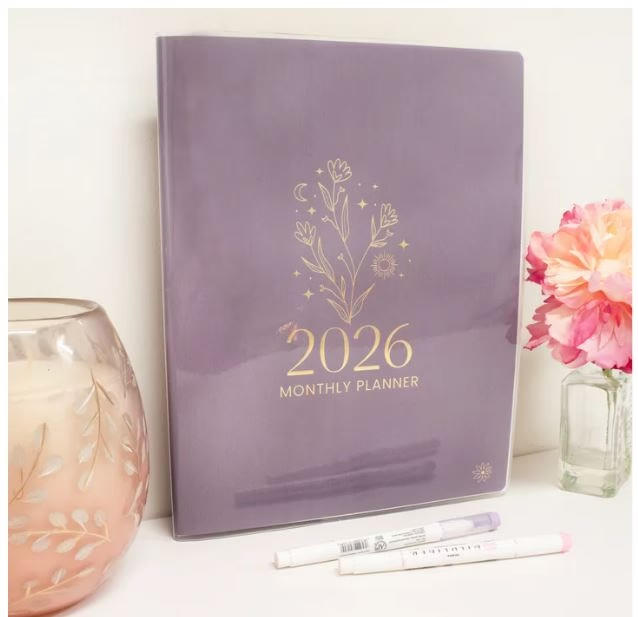Trying to stay on top of everything, including work, home, school, and your personal life, gets harder when your time feels scattered. Some people need structure by the hour, while others just want a better look at the month ahead. So, when one planner gives both views in a single place, it’s worth considering.
In this blog, we will walk you through what features help in a 2025-26 planner weekly and monthly format, why this layout works for a wide range of users, and how to make it suit your habits, not just your schedule.
What to Check Before You Choose
A 2025-26 planner weekly and monthly layout should feel like something you want to open, not just another thing on your desk. The features don’t need to be fancy, but they do need to work well together.
- Monthly Boxes That Don’t Feel Cramped
Some monthly calendars squeeze everything into tiny boxes. That makes it tough to jot down events, birthdays, appointments, or reminders without writing in the margins. Look for large, open monthly layouts. They make it easier to glance through your plans and spot what’s coming.
- Weekly Pages That Match Your Style
Weekly spreads come in a few formats, like horizontal lines, vertical columns, and even grid layouts. The right one depends on how you think. If your days are packed with meetings or classes, vertical columns may work better. If your weeks include tasks that don’t need time stamps, horizontal may feel simpler. Try to choose one that lets you keep notes without squeezing them into awkward corners.
- Strong Cover and Binding
Since this planner will likely cover a year and a half, it needs to hold up through daily use. A solid cover (flexible or hardcover) keeps pages safe. Sturdy binding, like sewn or high-quality coil, prevents it from falling apart by next spring.
- Paper That Doesn’t Bleed Through
You might use highlighters, gel pens, or markers. Thin paper can let ink show on the other side, which makes it harder to read or write. Thicker paper feels better to write on and holds up longer. It’s a small detail, but it makes planning feel smoother.
- Extras That Actually Help
Some planners include extras like goal pages, to-do lists, tabs, or pocket folders. These can be helpful if they’re well thought out. But too many extras can feel distracting. Think about what you’ll use, and what might just take up space.
Who Benefits Most from Dual-Format Layouts?
Many people need both an overview and details in the same place. The layout works especially well if your schedule shifts throughout the year.
- Students can use the monthly view for deadlines and exams, while the weekly pages handle study plans and class notes.
- Parents often juggle work, school events, appointments, and more. A dual layout helps you keep track of all of it without flipping between tools.
- Teachers and educators benefit from longer-term lesson planning paired with weekly task lists and meetings.
- Professionals working across projects, teams, or departments can use one section to track big dates and the other for daily actions.
Even if your lifestyle changes, like switching jobs or going back to school, this kind of layout can keep up without needing a new system.
How to Make the Most of Weekly and Monthly Spreads
Once you find a format that fits, using it well makes all the difference. These habits can help:
- Use the monthly spread like a dashboard: Add birthdays, trips, goals, or billing dates here. You can color-code categories if that keeps things clearer.
- Plan your week every Sunday (or Monday): Take 10 minutes to map the days ahead using the weekly layout.
- Set monthly goals before the first day: Simple goals like “read two books” or “organize photos” can help keep you motivated without pressure.
- Leave some space open: You don’t need to fill every box. The white space lets your brain rest, too.
Small Details That Are Easy to Miss
Some things don’t seem important until you start using the planner. Here’s what to keep an eye on:
- A built-in pocket folder: Helpful for receipts, loose notes, or appointment cards.
- A ribbon marker: Saves time when flipping between weeks and months.
- Start of the week: Some planners begin on Sunday, others on Monday. Choose what matches your mental flow.
- Blank pages or note sections: Great for thoughts that don’t fit in the calendar.
These little features don’t make the whole planner, but they can quietly improve how you use it.
Conclusion
A planner doesn’t need to be packed with extras to be useful. It just needs to work the way your brain does. A 2025-26 planner weekly and monthly format offers enough structure without boxing you in. You can shift between short-term tasks and long-term planning without flipping through extra notebooks or relying on memory.
In the next couple of years, as routines keep shifting and people lean toward flexible tools, planners that keep things simple and clear will probably become even more useful. It’s less about doing more and more about staying balanced.







